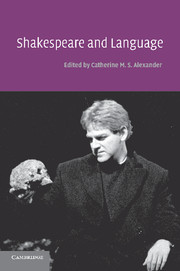Book contents
- Frontmatter
- Contents
- List of contributors
- Editor's note
- 1 Shakespeare and language: an introduction
- 2 Shakespeare's language and the language of Shakespeare's time
- 3 The foundations of Elizabethan language
- 4 Shakespeare's talking animals
- 5 Some functions of Shakespearian word-formation
- 6 Shakespeare and the tune of the time
- 7 Shakespeare's Romeo and Juliet: the places of invention
- 8 Shakespeare's thematic modes of speech: Richard II to Henry V
- 9 Hamlet and the power of words
- 10 The art of the comic duologue in three plays by Shakespeare
- 11 Hamlet's ear
- 12 ‘Voice potential’: language and symbolic capital in Othello
- 13 The aesthetics of mutilation in Titus Andronicus
- 14 ‘Time for such a word’: verbal echoing in Macbeth
- 15 Household words: Macbeth and the failure of spectacle
- 16 Late Shakespeare: style and the sexes
- Index
11 - Hamlet's ear
Published online by Cambridge University Press: 15 December 2009
- Frontmatter
- Contents
- List of contributors
- Editor's note
- 1 Shakespeare and language: an introduction
- 2 Shakespeare's language and the language of Shakespeare's time
- 3 The foundations of Elizabethan language
- 4 Shakespeare's talking animals
- 5 Some functions of Shakespearian word-formation
- 6 Shakespeare and the tune of the time
- 7 Shakespeare's Romeo and Juliet: the places of invention
- 8 Shakespeare's thematic modes of speech: Richard II to Henry V
- 9 Hamlet and the power of words
- 10 The art of the comic duologue in three plays by Shakespeare
- 11 Hamlet's ear
- 12 ‘Voice potential’: language and symbolic capital in Othello
- 13 The aesthetics of mutilation in Titus Andronicus
- 14 ‘Time for such a word’: verbal echoing in Macbeth
- 15 Household words: Macbeth and the failure of spectacle
- 16 Late Shakespeare: style and the sexes
- Index
Summary
An alienation from the hypocrisy of a courtly style or decorum in language afflicts Hamlet from his first appearance in the play. The courtly airs or ‘songs’, the ‘words of so sweet breath’, the ‘music vows’, with which he wooed Ophelia are no longer part of his idiom, although he will briefly redeploy them to disguise his true state of mind. In Act i scene 2, we meet a Hamlet whose abrupt retreat from social intercourse is not only signalled by his mourning dress, but is also articulated through an intensely satiric relationship to language. This scathing view of the world is articulated in all of Hamlet's language, in his soliloquies and monologues as well as in his dialogues with others; it finds its most effective form of expression, however, in his use of word-play. Indeed, before the final tragic catastrophe Hamlet's role as malcontent and revenger succeeds not so much by action as by his disordering, through punning, of social constructions of identity. The centrality of the pun to the view of earthly mutability and death which Hamlet gradually elaborates in the course of the play is aptly illustrated by the fact that he puns not only on his own death (‘The rest is silence’), but also as he finally accomplishes his task of revenge and kills Claudius, asking ‘Is thy union here?’ as he forces him to drink the wine that Claudius has poisoned with a pearl or ‘union’.
- Type
- Chapter
- Information
- Shakespeare and Language , pp. 201 - 212Publisher: Cambridge University PressPrint publication year: 2004



